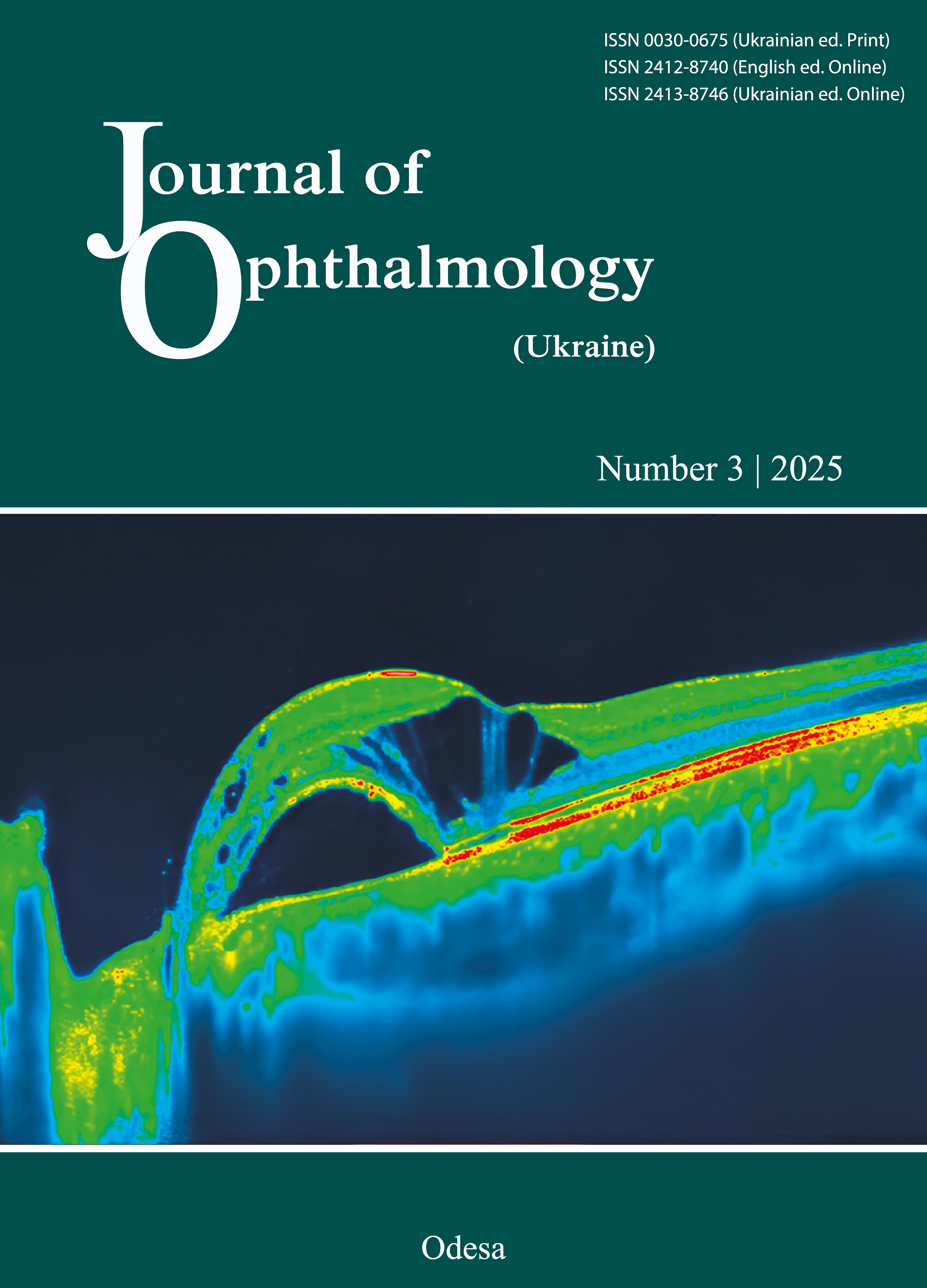Determining correlations between the grade of lens opacity and tear levels of total antioxidant activity and lipid peroxidation products in patients having both cataract and bacterial keratitis
DOI:
https://doi.org/10.31288/oftalmolzh202531519Keywords:
cataract, keratitis, lipid peroxidation, total antioxidant activity, antioxidant enzymes, methyl-ethyl pyridinol hydrochloride, lens, cornea, tear fluidAbstract
Purpose: To determine correlations between the grade of lens opacity and tear levels of total antioxidant activity (TAA) and lipid peroxidation (LPO) products in patients having both cataract and bacterial keratitis treated versus not treated with methyl-ethyl pyridinol hydrochloride (MH).
Methods: Patients of the study group had both senile cataract and bacterial stromal keratitis; they received MH (nine four-week cycles of daily treatment with MH separated by four-week breaks) as an adjunct to the conventional antibacterial treatment. Patients that received the conventional antibacterial treatment only were used as controls. The development of senile cataract in patients with keratitis was followed up for 18 months. Severity of lens opacity was assessed by slit lamp biomicroscopy and scored on a scale of 0 to 5. Tear levels of TAA, malondialdehyde (MDA) and diene conjugate (DC) were determined in patients with keratitis only and those having both keratitis and cataract. Spearman’s rank correlation was used to determine associations between the grade of lens opacity and tear levels of metabolic characteristics.
Results: Correlations between the grade of lens opacity and tear levels of TAA, MDA and DC were higher for patients having both cataract and keratitis and treated with MH than for patients with keratitis only. There were correlations of the grade of lens opacity with tear levels of TAA, MDA and DC (R=-0.85, R=0.80 and R=0.65, respectively) and of the tear level of TAA with tear levels of MDA and DC (R=-0.84 and R=-0.72, respectively) for patients having both cataract and bacterial keratitis and treated with MH.
Conclusion: Our findings of apparent correlations of the grade of lens opacity with the parameters of the oxidative-antioxidatiove system in the tear fluid of patients indicate a pathogenetic role of bacterial keratitis in the development of cataract. MH has antioxidative properties and may be used for correcting metabolic abnormalities and preventing structural and functional changes in the lens in cataractogenesis with corneal inflammation.
References
Hashemi H, Pakzad R, Yekta A, Aghamirsalim M, Pakbin M, Ramin S et al. Global and regional prevalence of age-related cataract: a comprehensive systematic review and meta-analysis. Eye. 2020;34:1357-70. https://doi.org/10.1038/s41433-020-0806-3
Latebo AA, Assefa NL, Ferede TW, Bekele MM, Demilew KZ. Prevalence of cataract and its associated factors among adults aged 40 years and above living in Durame town, Southern Ethiopia, 2023: a community-based cross-sectional study. BMJ Open. 2024;14(12):e089741. https://doi.org/10.1136/bmjopen-2024-089741
Sarkar D, Sharma R, Singh P, Verma V, Karkhur S, Verma S et al. Age-related cataract - Prevalence, epidemiological pattern and emerging risk factors in a cross-sectional study from Central India. Indian J Ophthalmol. 2023;71(5):1905-12.
https://doi.org/10.4103/ijo.IJO_2020_22
Yeh LJ, Shen TC, Sun KT, Lin CL, Hsia NY. Periodontitis and Subsequent Risk of Cataract: Results From Real-World Practice. Front Med (Lausanne). 2022;9:721119. https://doi.org/10.3389/fmed.2022.721119
Ung L, Chodosh J. Foundational concepts in the biology of bacterial keratitis. Exp Eye Res. 2021;209:108647. https://doi.org/10.1016/j.exer.2021.108647
Li X, Du GL, Wu SN, Sun YQ, Zhang SQ, Zhang ZJ et al. Association between systemic immune inflammation index and cataract incidence from 2005 to 2008. Sci Rep. 2025;15(1):499. https://doi.org/10.1038/s41598-024-84204-7
Huang J, Wu H, Yu F, Wu F, Hang C, Zhang X et al. Association between systemic immune-inflammation index and cataract among outpatient US adults. Front Med (Lausanne). 2024;11:1469200. https://doi.org/10.3389/fmed.2024.1469200
Fiolka R, Wylęgała E, Toborek M, Szkodny D, Czuba Z, Wylęgała A. Fuch's Endothelial Corneal Dystrophy in Cataract Patients Is Associated with Elevated Levels of Inflammatory Chemokines, but Not Growth Factors, in the Aqueous Humor. Int J Mol Sci. 2024; 25(3):1894. https://doi.org/10.3390/ijms25031894
Lotti R, Dart JKG. Cataract a s a complication of severe microbial keratitis. Eye.1992;6:400-03. doi: 10.1038/eye.1992.82. https://doi.org/10.1038/eye.1992.82
Kulbay M, Wu KY, Nirwal GK, Bélanger P, Tran SD. Oxidative Stress and Cataract Formation: Evaluating the Efficacy of Antioxidant Therapies. Biomolecules. 2024; 14(9):1055. https://doi.org/10.3390/biom14091055
Zhang Y, Jiang W, Xie Z, Wu W, Zhang D. Vitamin E and risk of age-related cataract: a meta-analysis. Public Health Nutr. 2015;18(15):2804-14. https://doi.org/10.1017/S1368980014003115
Xu J, Fu Q, Chen X, Yao K. Advances in pharmacotherapy of cataracts. Ann Transl Med. 2020;8(22):1552. https://doi.org/10.21037/atm-20-1960
McCusker MM, Durrani K, Payette MJ, Suchecki J. An eye on nutrition: The role of vitamins, essential fatty acids, and antioxidants in age-related macular degeneration, dry eye syndrome, and cataract. Clin Dermatol. 2016;34(2):276-85. https://doi.org/10.1016/j.clindermatol.2015.11.009
Gupta DS, Bagwe Parab S, Kaur G. Promising effects of emoxypine and its succinate derivative in the management of various diseases-with insights on recent patent applications. Curr Res Pharmacol Drug Discov. 2022;3:100121. https://doi.org/10.1016/j.crphar.2022.100121
Brown NA, Bron AJ, Ayliffe W, Sparrow J, Hill AR. The objective assessment of cataract. Eye (Lond). 1987;1(Pt2):234-46. https://doi.org/10.1038/eye.1987.43
Usov VIa, Tarik Abou Tarboush. [Longitudinal changes in the levels of lipid peroxidation and total antioxidant activity in the tear fluid of patients with keratitis treated with emaksipin]. Oftalmol Zh. 2011;4:26-9. Russian.
Usov VIa, Tarik Abou Tarboush. [Clinical observations of the development of cataract in patients with keratitis]. Problemy ekologichnoi ta medychnoi genetyky i klitynnoi imunologii. Kyiv-Lugans'k. 2013;6(120):323-32. Ukrainian.
Nsonwu M, Ozims SJ, Nnodim JK. Perspective of cataract and oxidative stress. Series Clin Biomed Res. 2024;1(1):1-10. https://doi.org/10.54178/2997-2701.v1i1a1994
Goodman D, Ness S. The Role of Oxidative Stress in the Aging Eye. Life. 2023; 13(3):837. https://doi.org/10.3390/life13030837
Atalay E, Oğurel T, Derici MK. The role of oxidative damage in cataract etiopathogenesis. Ther Adv Ophthalmol. 2023;15:25158414231168813. https://doi.org/10.1177/25158414231168813
Ruban VV, Archana PT, Sundararajan M, Geraldine P, Thomas PA. Inflammation and oxidative stress in corneal tissue in experimental keratitis due to Fusarium solani: Amelioration following topical therapy with voriconazole and epigallocatechin gallate. Mycoses. 2018;61(3):159-71. https://doi.org/10.1111/myc.12718
Ruban VV, Anbukkarasi М, Anand Т, Thomas Ph A, Geraldine Р. Oxidative stress in corneal tissue in experimental keratitis due to Aspergillus flavus: Effect of topical voriconazole therapy. Biocatalysis and Agricultural Biotechnology. 2019;21:101323. https://doi.org/10.1016/j.bcab.2019.101323
Kravets BB, Regeda MS. [The role of corvitin in the correction of violations of lipid peroxidation processes and the activity of the antioxidant system in guinea pigs blood in experimental bacterial keratitis against the background of bronchial asthma and pneumonia]. Medychna ta klinichna khimiia. 2015; 17(2): 69-71. Ukrainian. https://doi.org/10.11603/mcch.2410-681X.2015.v17.i2.4874
Usov VIa, Tarik Abou Tarboush, Kolomiichuk SG. [Correlations of parameters of the oxidative-antioxidative system in the lens, aqueous humor and tear fluid with the grade of lens opacity in rabbits with cataract and/or bacterial keratitis: an experimental study]. J of Ophthalmology (Ukraine). 2025;2:49-57.
Honisch C, Rodella U, Gatto C, Ruzza P, Tóthová JD. Oxidative Stress and Antioxidant-Based Interventional Medicine in Ophthalmology. Pharmaceuticals (Basel). 2023;16(8):1146. https://doi.org/10.3390/ph16081146
Chen Q, Han X, Liu L, Duan Y, Chen Y, Shi L et al. Multifunctional Polymer Vesicles for Synergistic Antibiotic-Antioxidant Treatment of Bacterial Keratitis. Biomacromolecules. 2023;24(11):5230-44. https://doi.org/10.1021/acs.biomac.3c00754
Downloads
Published
How to Cite
Issue
Section
License
Copyright (c) 2025 Usov V.Ia., Tarik Abou Tarboush, Kolomiichuk S.G.

This work is licensed under a Creative Commons Attribution 4.0 International License.
This work is licensed under a Creative Commons Attribution 4.0 International (CC BY 4.0) that allows users to read, download, copy, distribute, print, search, or link to the full texts of the articles, or use them for any other lawful purpose, without asking prior permission from the publisher or the author as long as they cite the source.
COPYRIGHT NOTICE
Authors who publish in this journal agree to the following terms:
- Authors hold copyright immediately after publication of their works and retain publishing rights without any restrictions.
- The copyright commencement date complies the publication date of the issue, where the article is included in.
DEPOSIT POLICY
- Authors are permitted and encouraged to post their work online (e.g., in institutional repositories or on their website) during the editorial process, as it can lead to productive exchanges, as well as earlier and greater citation of published work.
- Authors are able to enter into separate, additional contractual arrangements for the non-exclusive distribution of the journal's published version of the work with an acknowledgement of its initial publication in this journal.
- Post-print (post-refereeing manuscript version) and publisher's PDF-version self-archiving is allowed.
- Archiving the pre-print (pre-refereeing manuscript version) not allowed.












